Impacts of Human Activities on Urban Sprawl and Land Surface Temperature in Rural Areas, a Case Study of El-Reyad District, Kafrelsheikh Governorate, Egypt
Abstract
:1. Introduction
2. Materials and Methods
2.1. Study Area
2.2. Land Use/Cover Classification
2.3. Estimating Land Surface Temperature Using GEE
2.3.1. CA–Markov Model
2.3.2. Accuracy Assessment
3. Results and Discussion
3.1. Monitoring Land Cover Changes
3.2. Spatiotemporal Changes in Land Cover/Use
3.3. Spatiotemporal Changes in Land Surface Temperature
3.4. Prediction of Land Use/Land Cover
4. Conclusions
Author Contributions
Funding
Institutional Review Board Statement
Informed Consent Statement
Data Availability Statement
Acknowledgments
Conflicts of Interest
References
- Chen, M.; Liu, W.; Lu, D. Challenges and the way forward in China’s new-type urbanization. Land Use Policy 2016, 55, 334–339. [Google Scholar] [CrossRef]
- Desa, U.N. World Urbanization Prospects, the 2011 Revision; Population Division, Department of Economic and Social Affairs, United Nations Secretariat: New York, NY, USA, 2014. [Google Scholar]
- Araya, Y.H.; Cabral, P. Analysis and Modeling of Urban Land Cover Change in Setúbal and Sesimbra, Portugal. Remote Sens. 2010, 2, 1549–1563. [Google Scholar] [CrossRef]
- Hamdi, H.; Abdelhafez, S. Agriculture and soil survey in Egypt. In Soil Resources of Southern and Eastern Mediterranean Countries; CIHEAM: Paris, France, 2001; pp. 111–130. [Google Scholar]
- Muñoz-Rojas, M.; Jordán, A.; Zavala, L.M.; De la Rosa, D.; Abd-Elmabod, S.K.; Anaya-Romero, M. Impact of land use and land cover changes on organic carbon stocks in Mediterranean soils (1956–2007). Land Degrad. Dev. 2015, 26, 168–179. [Google Scholar] [CrossRef]
- El Nahry, A.H.; Mohamed, E.S. Potentiality of land and water resources in African Sahara: A case study of south Egypt. Environ. Earth Sci. 2011, 63, 1263–1275. [Google Scholar] [CrossRef]
- AbdelRahman, M.A.; Saleh, A.M.; Arafat, S.M. Assessment of land suitability using a soil-indicator-based approach in a geomatics environment. Sci. Rep. 2022, 12, 18113. [Google Scholar] [CrossRef] [PubMed]
- Elfadaly, A.; Lasaponara, R. On the use of satellite imagery and GIS tools to detect and characterize the urbanization around heritage sites: The case studies of the Catacombs of Mustafa Kamel in Alexandria, Egypt and the Aragonese Castle in Baia, Italy. Sustainability 2019, 11, 2110. [Google Scholar] [CrossRef]
- Abu-Hashim, M.; Lilienthal, H.; Schnug, E.; Lasaponara, R.; Mohamed, E.S. Can a Change in Agriculture Management Practice Improve Soil Physical Properties. Sustainability 2023, 15, 3573. [Google Scholar] [CrossRef]
- Shalaby, A.; Gad, A. Urban Sprawl Impact Assessment on The Fertile Agricultural Land of Egypt Using Remote Sensing and Digital Soil Database, Case Study: Qalubiya Governorate. In Proceedings of the US Egypt Workshop on Space Technology and Geoinformation for Sustainable Development, Cairo, Egypt, 14–17 June 2010; Volume 1417, p. 12. [Google Scholar]
- Kalnay, E.; Cai, M. Impact of Urbanization and Land-Use Change on Climate. Nature 2003, 423, 528–531. [Google Scholar] [CrossRef] [PubMed]
- Li, D.; Wu, S.; Liang, Z.; Li, S. The Impacts of Urbanization and Climate Change on Urban Vegetation Dynamics in China. Urban For. Urban Green. 2020, 54, 126764. [Google Scholar] [CrossRef]
- Li, X.; Stringer, L.C.; Dallimer, M. The Impacts of Urbanisation and Climate Change on The Urban Thermal Environment in Africa. Climate 2022, 10, 164. [Google Scholar] [CrossRef]
- Mohajerani, A.; Bakaric, J.; Jeffrey-Bailey, T. The Urban Heat Island Effect, Its Causes, and Mitigation, with Reference to the Thermal Properties of Asphalt Concrete. J. Environ. Manag. 2017, 197, 522–538. [Google Scholar] [CrossRef] [PubMed]
- Abulibdeh, A. Analysis of Urban Heat Island Characteristics and Mitigation Strategies For Eight Arid and Semi-Arid Gulf Region Cities. Environ. Earth Sci. 2021, 80, 1–26. [Google Scholar] [CrossRef]
- Leal Filho, W.; Wolf, F.; Castro-Díaz, R.; Li, C.; Ojeh, V.N.; Gutiérrez, N.; Bönecke, J. Addressing The Urban Heat Islands Effect: A Cross-Country Assessment of The Role of Green infrastructure. Sustainability 2021, 13, 753. [Google Scholar] [CrossRef]
- El-Zeiny, A.; Effat, H.; Mansour, K.; Shahin, A.; Elwan, K. Geo-environmental monitoring of coastal and land resources of Port Said Governorate, Egypt. Egypt. J. Remote Sens. Space Sci. 2022, 25, 157–172. [Google Scholar] [CrossRef]
- Boumaza, B.; Chekushina, T.V.; Kechiched, R.; Benabdeslam, N.; Brahmi, L.; Kucher, D.E.; Rebouh, N.Y. Environmental Geochemistry of Potentially Toxic Metals in Phosphate Rocks, Products, and Their Wastes in the Algerian Phosphate Mining Area (Tébessa, NE Algeria). Minerals 2023, 13, 853. [Google Scholar] [CrossRef]
- Hendawy, E.; Belal, A.A.; Mohamed, E.S.; Elfadaly, A.; Murgante, B.; Aldosari, A.A.; Lasaponara, R. The Prediction and Assessment of The Impacts of Soil Sealing on Agricultural Land in The North Nile Delta (Egypt) Using Satellite Data and GIS Modeling. Sustainability 2019, 11, 4662. [Google Scholar] [CrossRef]
- Tadese, S.; Soromessa, T.; Bekele, T. Analysis of The Current and Future Prediction of Land Use/Land Cover Change Using Remote Sensing and The CA-Markov Model in Majang Forest Biosphere Reserves of Gambella, Southwestern Ethiopia. Sci. World J. 2021, 2021, 6685045. [Google Scholar] [CrossRef]
- Vinayak, B.; Lee, H.S.; Gedem, S. Prediction of Land Use and Land Cover Changes in Mumbai City, India, Using Remote Sensing Data and A Multilayer Perceptron Neural Network-Based Markov Chain Model. Sustainability 2021, 13, 471. [Google Scholar] [CrossRef]
- Belal, A.A.; Mohamed, E.S.; Abu-Hashim, M.S.D. Land evaluation based on GIS-spatial multi-criteria evaluation (SMCE) for agricultural development in dry Wadi, Eastern Desert, Egypt. Int. J. Soil Sci. 2015, 10, 100–116. [Google Scholar] [CrossRef]
- Athukorala, D.; Murayama, Y. Urban Heat Island Formation in Greater Cairo: Spatio-Temporal Analysis of Daytime and Nighttime Land Surface Temperatures Along The Urban–Rural Gradient. Remote Sens. 2021, 13, 1396. [Google Scholar] [CrossRef]
- Mujabar, P.S. Spatial-Temporal Variation of Land Surface Temperature of Jubail industrial City, Saudi Arabia Due to Seasonal Effect by Using Thermal infrared Remote Sensor (TIRS) Satellite Data. J. Afr. Earth Sci. 2019, 155, 54–63. [Google Scholar] [CrossRef]
- Abd-Elmabod, S.K.; Fitch, A.C.; Zhang, Z.; Ali, R.R.; Jones, L. Rapid urbanisation threatens fertile agricultural land and soil carbon in the Nile delta. J. Environ. Manag. 2019, 252, 109668. [Google Scholar] [CrossRef] [PubMed]
- Imhoff, M.L.; Zhang, P.; Wolfe, R.E.; Bounoua, L. Remote sensing of the urban heat island effect across biomes in the continental USA. Remote Sens. Environ. 2010, 114, 504–513. [Google Scholar] [CrossRef]
- Myint, S.W.; Wentz, E.A.; Brazel, A.J.; Quattrochi, D.A. The impact of distinct anthropogenic and vegetation features on urban warming. Landsc. Ecol. 2013, 28, 959–978. [Google Scholar] [CrossRef]
- Yuan, F.; Bauer, M.E. Comparison of impervious surface area and normalized difference vegetation index as indicators of surface urban heat island effects in Landsat imagery. Remote Sens. Environ. 2007, 106, 375–386. [Google Scholar] [CrossRef]
- Adams, M.P.; Smith, P.L. A systematic approach to model the influence of the type and density of vegetation cover on urban heat using remote sensing. Landsc. Urban Plan. 2014, 132, 47–54. [Google Scholar] [CrossRef]
- Owen, T.W.; Carlson, T.N.; Gillies, R.R. An assessment of satellite remotely-sensed land cover parameters in quantitatively describing the climatic effect of urbanization. Int. J. Remote Sens. 1998, 19, 1663–1681. [Google Scholar] [CrossRef]
- Zhou, W.; Qian, Y.; Li, X.; Li, W.; Han, L. Relationships between land cover and the surface urban heat island: Seasonal variability and effects of spatial and thematic resolution of land cover data on predicting land surface temperatures. Landsc. Ecol. 2014, 29, 153–167. [Google Scholar] [CrossRef]
- Guo, G.; Wu, Z.; Xiao, R.; Chen, Y.; Liu, X.; Zhang, X. Impacts of urban biophysical composition on land surface temperature in urban heat island clusters. Landsc. Urban Plan. 2015, 135, 1–10. [Google Scholar] [CrossRef]
- Tran, D.X.; Pla, F.; Latorre-Carmona, P.; Myint, S.W.; Caetano, M.; Kieu, H.V. Characterizing the relationship between land use land cover change and land surface temperature. ISPRS J. Photogramm. Remote Sens. 2017, 124, 119–132. [Google Scholar] [CrossRef]
- Liu, X.; Hu, G.; Chen, Y.; Li, X.; Xu, X.; Li, S.; Wang, S. High-resolution multi-temporal mapping of global urban land using Landsat images based on the Google Earth Engine Platform. Remote Sens. Environ. 2018, 209, 227–239. [Google Scholar] [CrossRef]
- Tassi, A.; Vizzari, M. Object-Oriented LULC Classification in Google Earth Engine Combining Snic, Glcm, and Machine Learning Algoritms. Remote Sens. 2020, 12, 3776. [Google Scholar] [CrossRef]
- Anderson, J.R. A Land Use and Land Cover Classification System for Use with Remote Sensor Data; US Government Printing Office: Washington, DC, USA, 1976; Volume 964.
- Gemmechis, W.A. Land Use Land Cover Dynamics Using CA-Markov Chain a Case of Belete Gera Forest Priority Area South Western Ethiopia. 2022. Available online: https://www.researchgate.net/publication/364156701_Land_use_land_cover_Dynamics_using_CA-Markov_Chain_A_case_of_Belete_Gera_Forest_Priority_Area_South_Western_Ethiopia (accessed on 10 May 2023).
- Olofsson, P.; Foody, G.M.; Herold, M.; Stehman, S.V.; Woodcock, C.E.; Wulder, M.A. Good Practices for Estimating Area and Assessing Accuracy of Land Change. Remote Sens. Environ. 2014, 148, 42–57. [Google Scholar] [CrossRef]
- Carletta, J. Assessing agreement on classification tasks: The kappa statistic. arXiv 1996, arXiv:cmp-lg/9602004. [Google Scholar]
- Pontius, R.G., Jr.; Millones, M. Death to Kappa: Birth of quantity disagreement and allocation disagreement for accuracy assessment. Int. J. Remote Sens. 2011, 32, 4407–4429. [Google Scholar] [CrossRef]
- Warrens, M.J. Properties of the quantity disagreement and the allocation disagreement. Int. J. Remote Sens. 2015, 36, 1439–1446. [Google Scholar] [CrossRef]
- Maxwell, A.E.; Warner, T.A. Thematic classification accuracy assessment with inherently uncertain boundaries: An argument for center-weighted accuracy assessment metrics. Remote Sens. 2020, 12, 1905. [Google Scholar] [CrossRef]
- Said, M.E.; Ali, A.M.; Borin, M.; Abd-Elmabod, S.K.; Aldosari, A.A.; Khalil, M.M.; Abdel-Fattah, M.K. On the use of multivariate analysis and land evaluation for potential agricultural development of the northwestern coast of Egypt. Agronomy 2020, 10, 1318. [Google Scholar] [CrossRef]
- AbdelRahman, M.A.; Afifi, A.A.; Scopa, A. A time series investigation to assess climate change and anthropogenic impacts on quantitative land degradation in the North Delta, Egypt. ISPRS Int. J. Geo-Inf. 2021, 11, 30. [Google Scholar] [CrossRef]
- AbdelRahman, M.A.; Shalaby, A.; Aboelsoud, M.H.; Moghanm, F.S. GIS spatial model based for determining actual land degradation status in Kafrelsheikh Governorate, North Nile Delta. Model. Earth Syst. Environ. 2018, 4, 359–372. [Google Scholar] [CrossRef]
- Jiménez-González, M.A.; Álvarez, A.M.; Carral, P.; Abd-Elmabod, S.K.; Almendros, G. The pyrolytical fingerprint of nitrogen compounds reflects the content and quality of soil organic carbon. Geoderma 2022, 428, 116187. [Google Scholar] [CrossRef]
- Abd El-Hamid, H.T.; Nour-Eldin, H.; Rebouh, N.Y.; El-Zeiny, A.M. Past and Future Changes of Land Use/Land Cover and the Potential Impact on Ecosystem Services Value of Damietta Governorate, Egypt. Land 2022, 11, 2169. [Google Scholar] [CrossRef]
- Lasner, T.; Mytlewski, A.; Nourry, M.; Rakowski, M.; Oberle, M. Carp land: Economics of fish farms and the impact of region-marketing in the Aischgrund (DEU) and Barycz Valley (POL). Aquaculture 2020, 519, 734731. [Google Scholar] [CrossRef]
- Hossen, H.; Negm, A. Change Detection in The Water Bodies of Burullus Lake, Northern Nile Delta, Egypt, Using RS/GIS. Procedia Eng. 2016, 154, 951–958. [Google Scholar] [CrossRef]
- Abd-Elmabod, S.K.; Bakr, N.; Muñoz-Rojas, M.; Pereira, P.; Zhang, Z.; Cerdà, A.; Jordán, A.; Mansour, H.; De la Rosa, D.; Jones, L. Assessment of soil suitability for improvement of soil factors and agricultural management. Sustainability 2019, 11, 1588. [Google Scholar] [CrossRef]
- AbdelRahman, M.A.; Metwalli, M.R.; Gao, M.; Toscano, F.; Fiorentino, C.; Scopa, A.; D’Antonio, P. Determining the Extent of Soil Degradation Processes Using Trend Analyses at a Regional Multispectral Scale. Land 2023, 12, 855. [Google Scholar] [CrossRef]
- AbdelRahman, M.A.E.; Natarajan, A.; Srinivasamurty, C.A.; Hegde, R. Estimating soil fertility status in physically degraded land using GIS and remote sensing techniques in Chamarajanagar district, Karnataka, India. Egypt. J. Remote Sens. Space Sci. 2016, 19, 95–108. [Google Scholar] [CrossRef]
- AbdelRahman, M.A.E.; Engel, B.; Eid, M.S.M.; Aboelsoud, H.M. A new index to assess soil sustainability based on Temporal Changes of Soil Measurements Using Geomatics–An example from El-Sharkia, Egypt. All Earth 2022, 34, 147–166. [Google Scholar] [CrossRef]
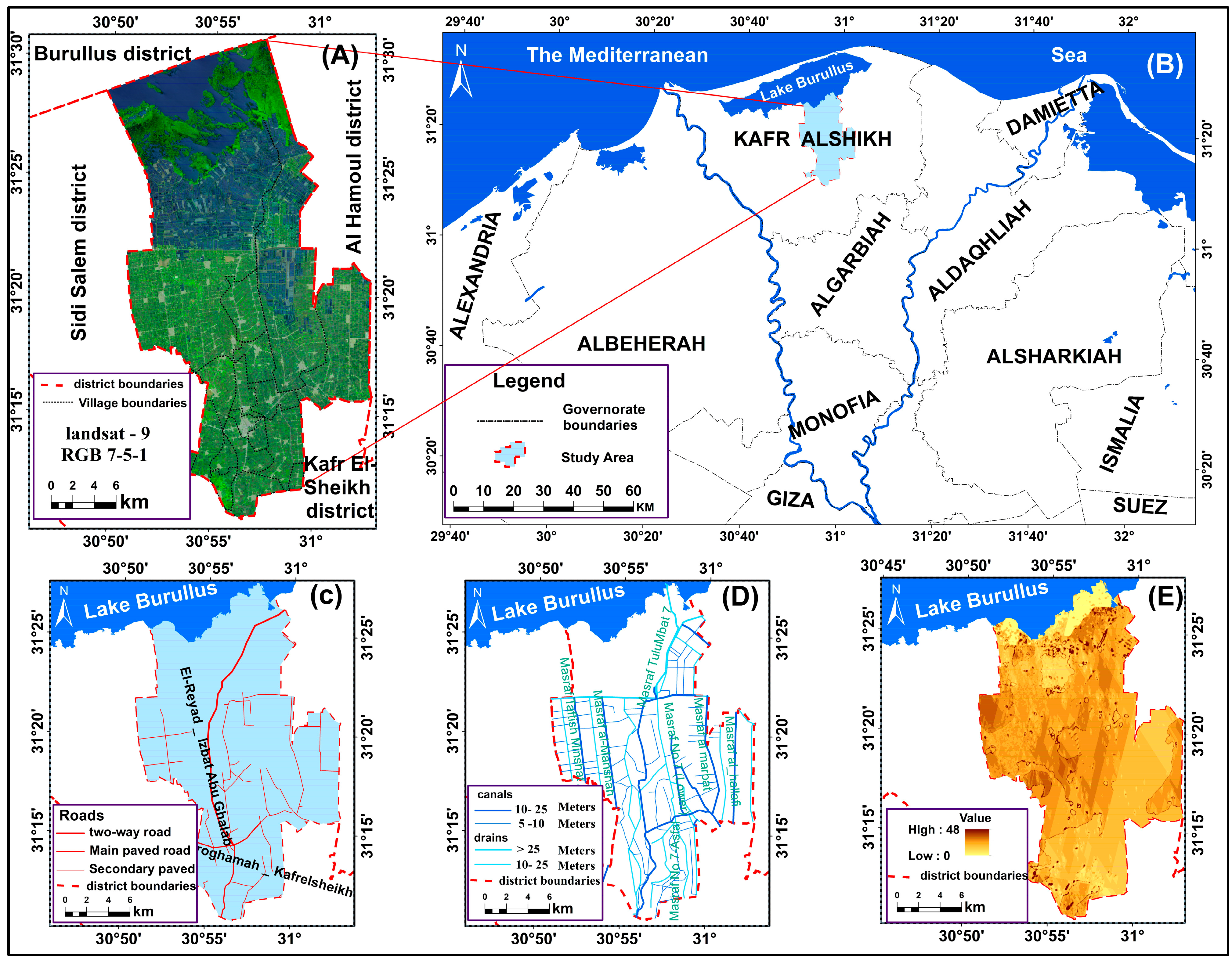
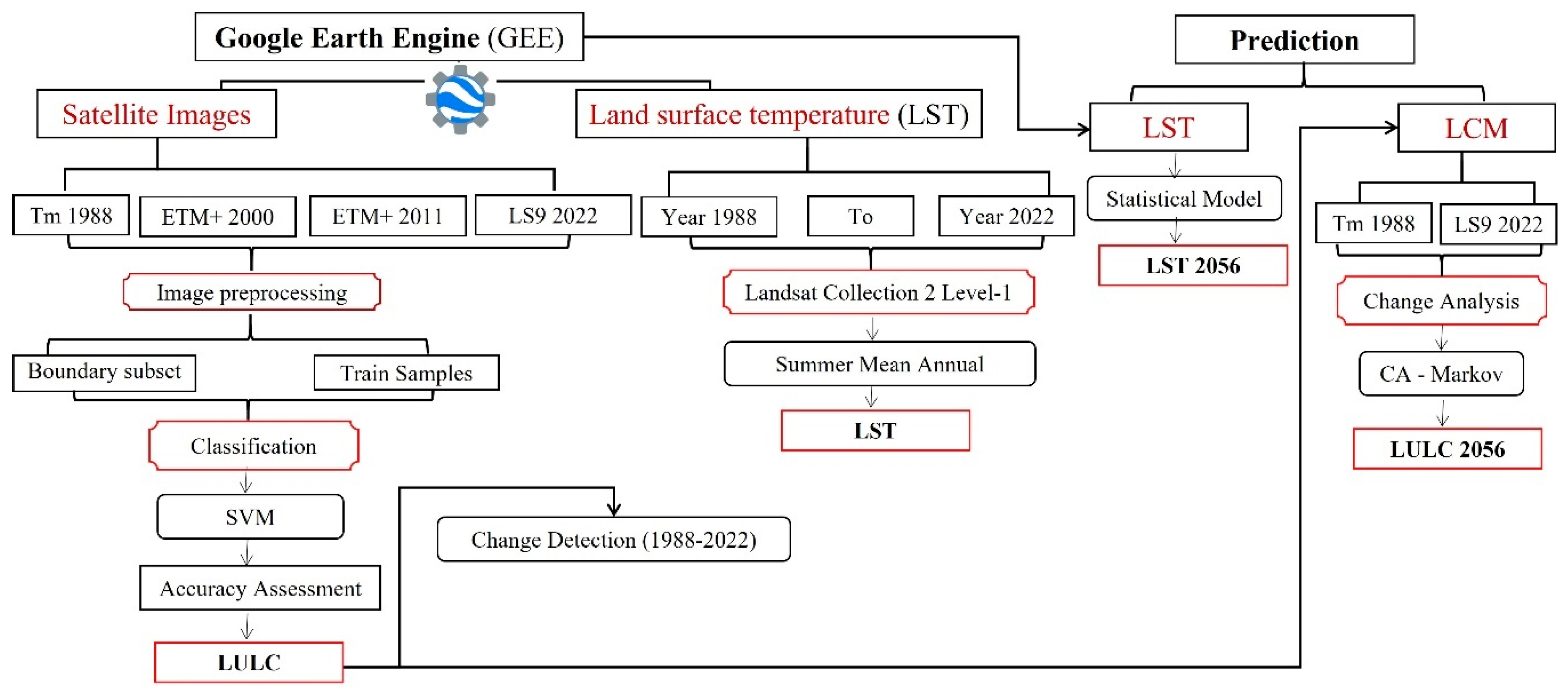


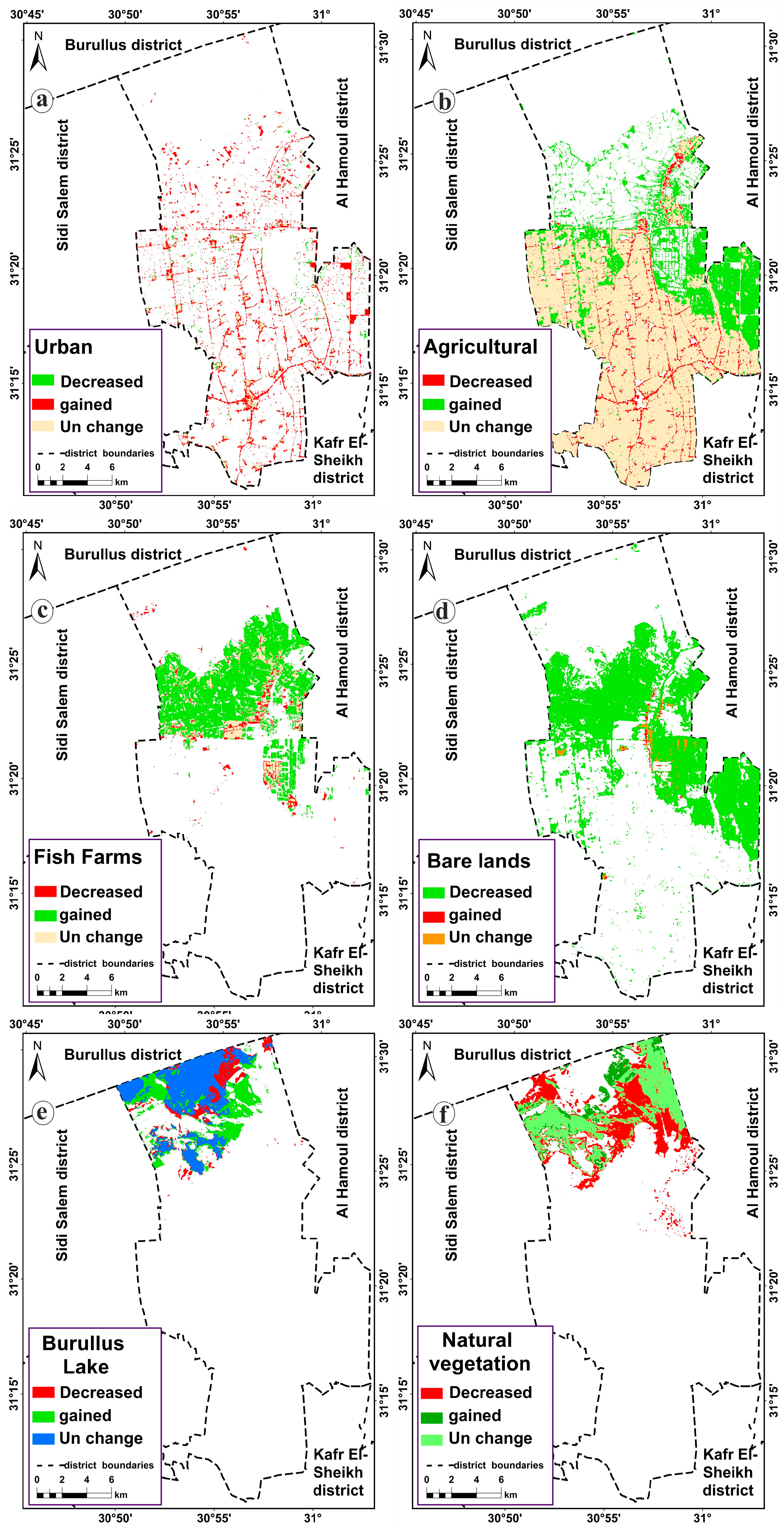
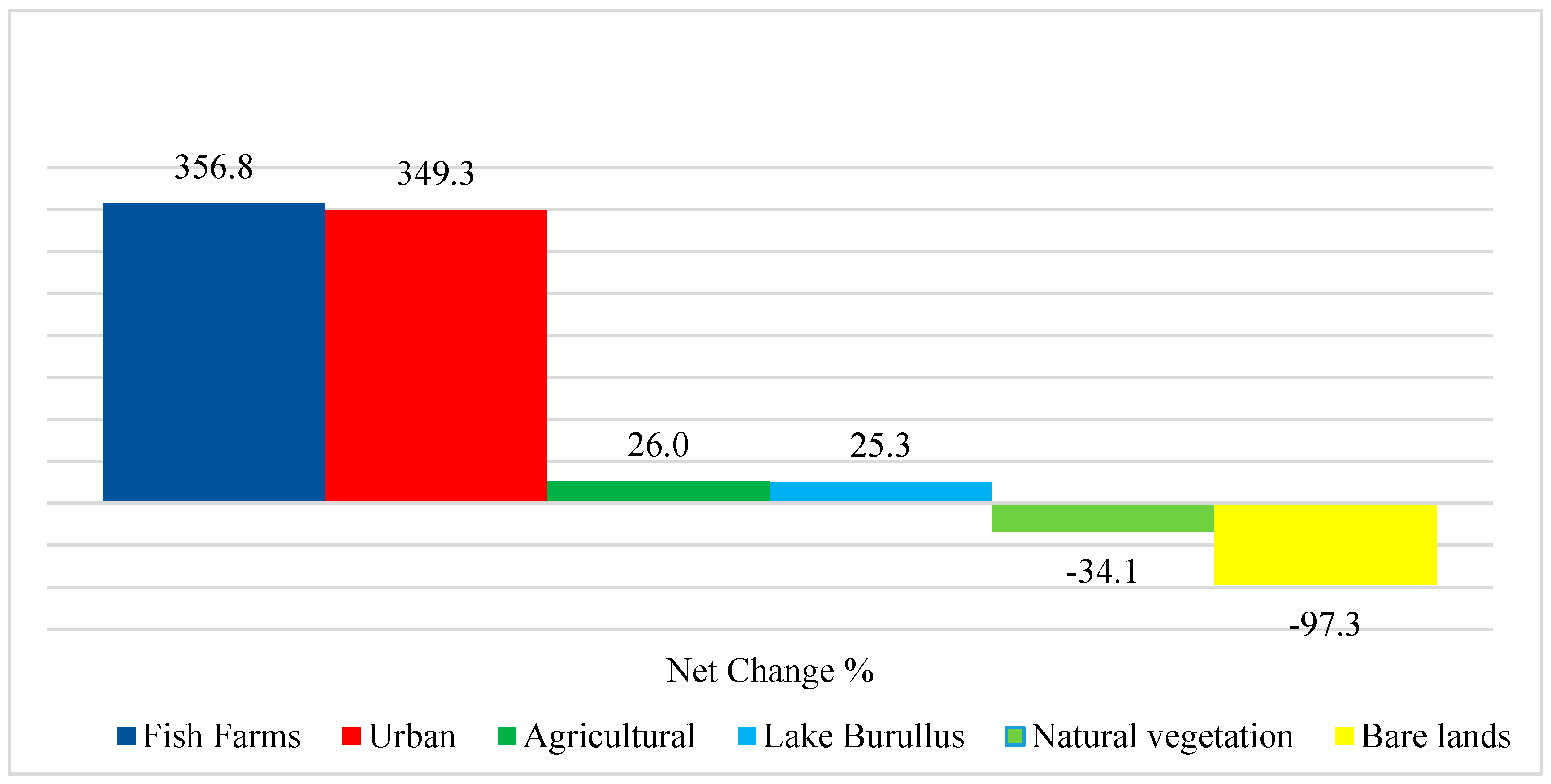
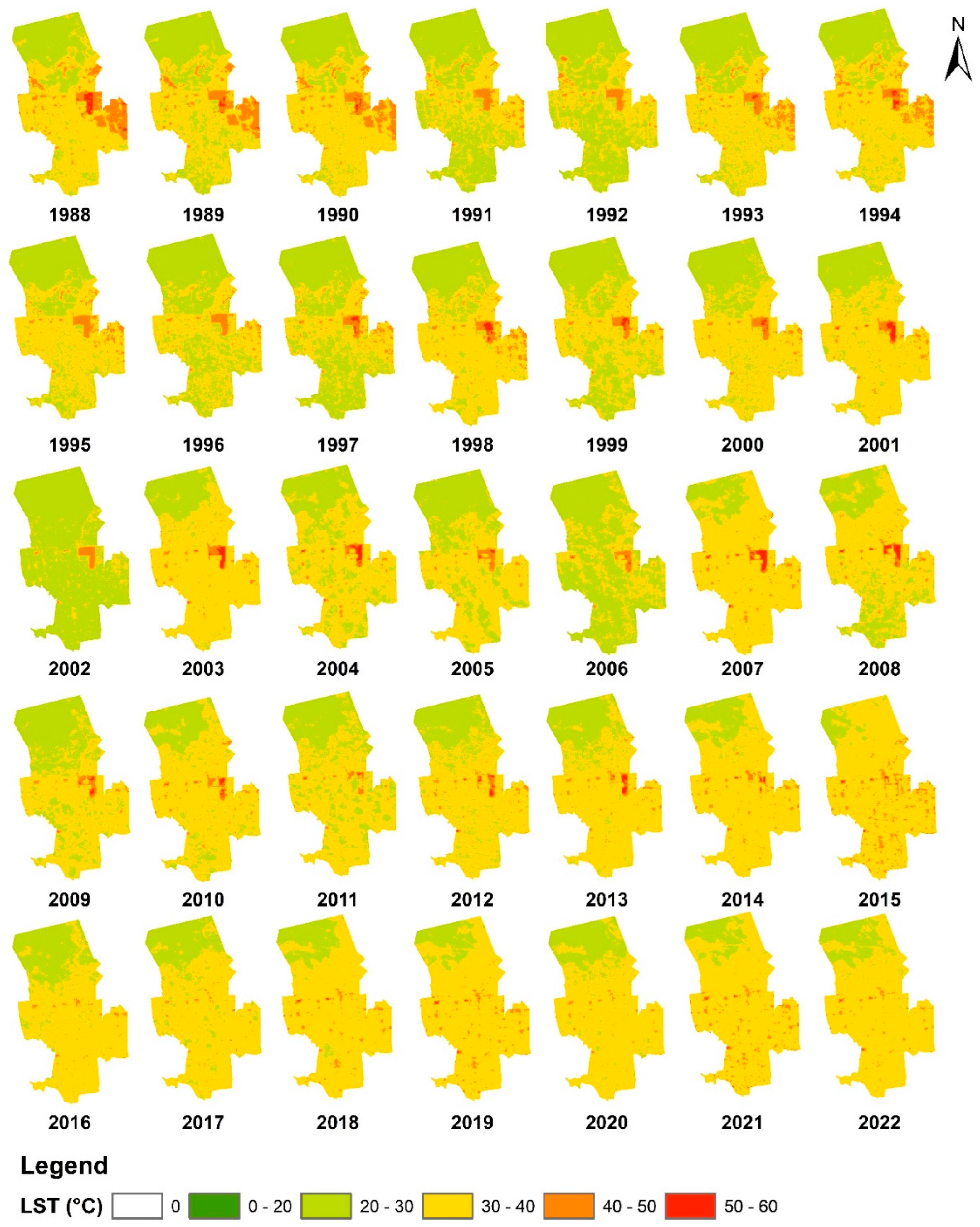
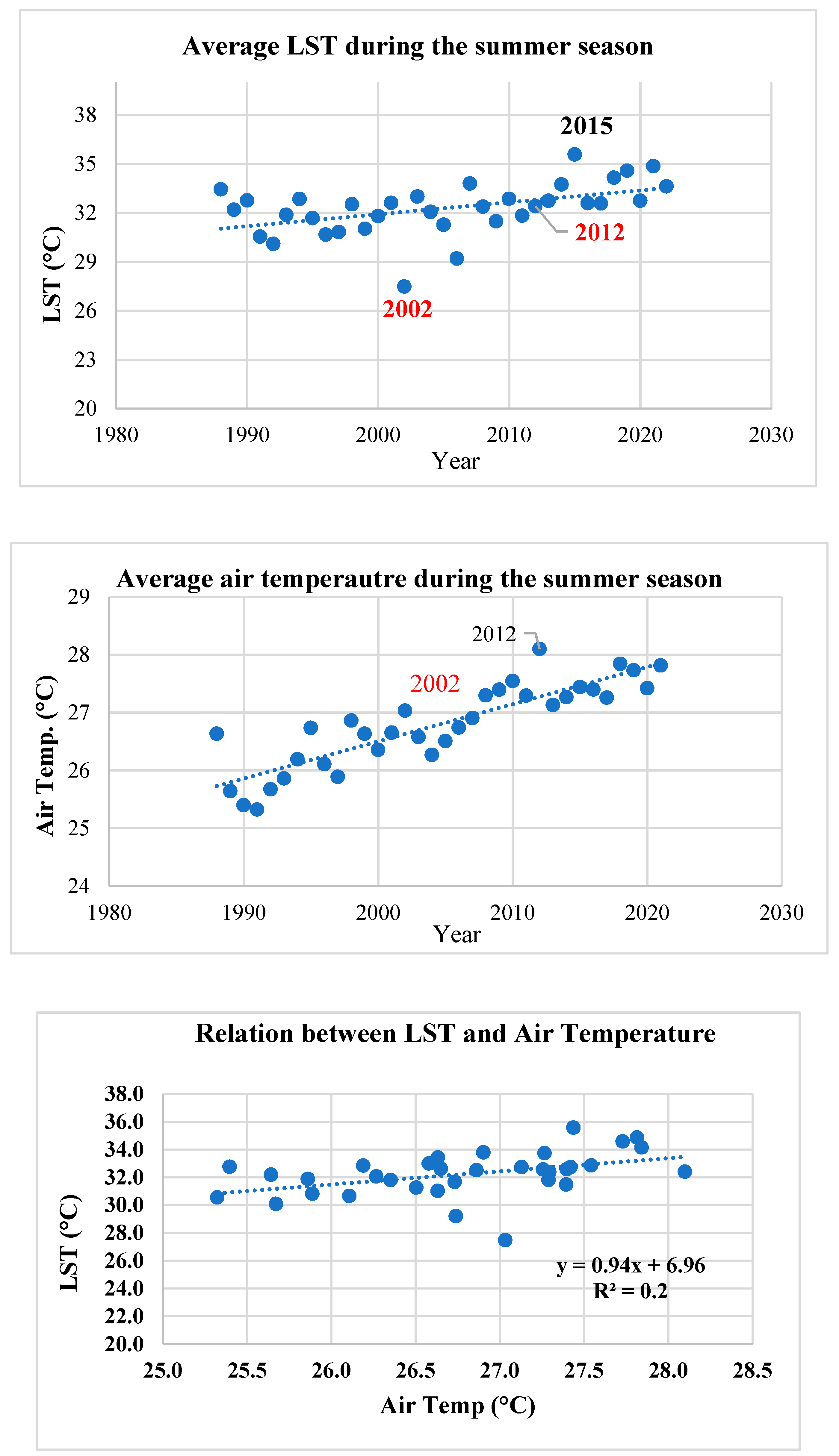

| LULC | 1988 | 2000 | 2011 | 2022 | ||||
|---|---|---|---|---|---|---|---|---|
| Producer (%) | User (%) | Producer (%) | User (%) | Producer (%) | User (%) | Producer (%) | User (%) | |
| Urban | 97.07 | 90.71 | 97.14 | 92.89 | 97.76 | 96.15 | 97.76 | 97.76 |
| Agricultural | 89.70 | 91.72 | 91.04 | 91.72 | 91.72 | 95.31 | 95.58 | 97.74 |
| Fish farms | 84.61 | 91.66 | 89.88 | 95.23 | 93.18 | 95.34 | 96.59 | 97.70 |
| Bare ands | 85.10 | 76.92 | 86.53 | 86.53 | 91.837 | 88.23 | 97.82 | 88.23 |
| Lake Burullus | 70.96 | 73.33 | 81.48 | 73.33 | 87.87 | 80.55 | 93.54 | 87.87 |
| Natural vegetation | 58.33 | 77.77 | 69.56 | 88.88 | 83.33 | 88.23 | 85 | 94.44 |
| Overall accuracy | 88.2 | 91 | 93.6 | 96.2 | ||||
| Kappa statistic | 0.84 | 0.88 | 0.915 | 0. 95 | ||||
| Quantity Disagreement | 0.03 | 0.025 | 0.018 | 0.01 | ||||
| Allocation Disagreement | 0.090 | 0.065 | 0.042 | 0.030 | ||||
| Land Cover | 1988 | 2000 | 2011 | 2022 | ||||
|---|---|---|---|---|---|---|---|---|
| Acre | % | Acre | % | Acre | % | Acre | % | |
| Urban | 1642.2 | 1.6 | 2737 | 2.6 | 5093.2 | 4.9 | 7378 | 7.1 |
| Agricultural | 45,791.2 | 44 | 56,953.4 | 54.7 | 59,285.8 | 56.9 | 57,715 | 55.4 |
| Fish farms | 3855.6 | 3.7 | 16,398.2 | 15.7 | 17,588.2 | 16.9 | 17,612 | 16.9 |
| Bare lands | 29,440.6 | 28.3 | 7354.2 | 7.1 | 2070.6 | 2 | 785.4 | 0.7 |
| Lake Burullus | 8853.6 | 8.5 | 11,114.6 | 10.7 | 10,186.4 | 9.8 | 11,090.8 | 10.6 |
| Natural vegetation | 14,589.4 | 14 | 9662.8 | 9.3 | 9948.4 | 9.5 | 9615.2 | 9.2 |
| Sum | 104,173 | 100 | 104,173 | 100 | 104,173 | 100 | 104,173 | 100 |
| Land Cover | Decreased (Acre) | % | Unchanged (Acre) | % | Increased (Acre) | % |
|---|---|---|---|---|---|---|
| Agricultural | 3950.8 | 9.0 | 41,816.6 | 69.3 | 15,874.6 | 36.3 |
| Urban | - | - | 1094.8 | 1.8 | 6283.2 | 10.4 |
| Fish Farms | 1404.2 | 3.2 | 2427.6 | 4.0 | 15,184.4 | 25.2 |
| Bare lands | 28,988.4 | 66.2 | 547.4 | 0.9 | - | - |
| Lake Burullus | 2237.2 | 5.1 | 6830.6 | 11.3 | 4260.2 | 9.7 |
| Natural Vegetation | 7187.6 | 16.4 | 7639.8 | 12.7 | 2189 | 5 |
| Total | 43,768.2 | 100.0 | 60,356.8 | 100.0 | 43,792 | 100.0 |
| 2022 | 2056 | Change | |||
|---|---|---|---|---|---|
| Acre | % | Acre | % | % | |
| Agricultural | 57,715 | 55.4 | 45,848.17 | 44.01 | −11.38 |
| Urban | 7378 | 7.1 | 12,258.3 | 11.7 | 4.66 |
| Fish Farms | 17,612 | 16.9 | 23,960.25 | 23.0 | 6.10 |
| Bare lands | 785.4 | 0.8 | 329.6467 | 0.39 | −0.48 |
| Lake Burullus | 11,090.8 | 10.6 | 9845.33 | 9.45 | −1.149 |
| Natural vegetation | 9615.2 | 9.2 | 11,924.32 | 11.44 | 2.24 |
| Sum | 437.7 | 100 | 437.7 | 100 | - |
| LST | 1988 | 2000 | 2011 | 2022 | 2056 |
|---|---|---|---|---|---|
| Min | 24.9 | 24.5 | 24.6 | 27.5 | 28 |
| Max | 54.0 | 52.1 | 53.0 | 54.4 | 59.9 |
| Average ± SD | 32.4 ± 0.5 | 31.8 ± 0.8 | 32.81 ± 0.3 | 33.6 ± 0.2 | 36 ± 0.5 |
Disclaimer/Publisher’s Note: The statements, opinions and data contained in all publications are solely those of the individual author(s) and contributor(s) and not of MDPI and/or the editor(s). MDPI and/or the editor(s) disclaim responsibility for any injury to people or property resulting from any ideas, methods, instructions or products referred to in the content. |
© 2023 by the authors. Licensee MDPI, Basel, Switzerland. This article is an open access article distributed under the terms and conditions of the Creative Commons Attribution (CC BY) license (https://creativecommons.org/licenses/by/4.0/).
Share and Cite
Mostafa, W.; Magd, Z.; Abo Khashaba, S.M.; Abdelaziz, B.; Hendawy, E.; Elfadaly, A.; Nabil, M.; Kucher, D.E.; Chen, S.; Mohamed, E.S. Impacts of Human Activities on Urban Sprawl and Land Surface Temperature in Rural Areas, a Case Study of El-Reyad District, Kafrelsheikh Governorate, Egypt. Sustainability 2023, 15, 13497. https://doi.org/10.3390/su151813497
Mostafa W, Magd Z, Abo Khashaba SM, Abdelaziz B, Hendawy E, Elfadaly A, Nabil M, Kucher DE, Chen S, Mohamed ES. Impacts of Human Activities on Urban Sprawl and Land Surface Temperature in Rural Areas, a Case Study of El-Reyad District, Kafrelsheikh Governorate, Egypt. Sustainability. 2023; 15(18):13497. https://doi.org/10.3390/su151813497
Chicago/Turabian StyleMostafa, Wael, Zenhom Magd, Saif M. Abo Khashaba, Belal Abdelaziz, Ehab Hendawy, Abdelaziz Elfadaly, Mohsen Nabil, Dmitry E. Kucher, Shuisen Chen, and Elsayed Said Mohamed. 2023. "Impacts of Human Activities on Urban Sprawl and Land Surface Temperature in Rural Areas, a Case Study of El-Reyad District, Kafrelsheikh Governorate, Egypt" Sustainability 15, no. 18: 13497. https://doi.org/10.3390/su151813497










